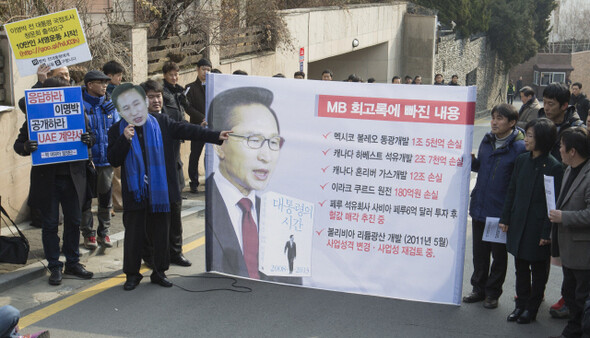hankyoreh
Links to other country sites 다른 나라 사이트 링크
Resource diplomacy ‘investments’ turn $30 billion into just $4.2 billion

Nearly US$30 billion in overseas resource development project investments by the South Korean government generated a return of just US$4.2 billion, according to a Board of Audit and Inspection (BAI) report released on Apr. 3.
The numbers mark the first official confirmation by a government agency of the “report card” for overseas development efforts under the Lee Myung-bak administration (2008-13), during which 27 trillion won (US$24.9 billion) was invested.
During a briefing on Apr. 3 to announce the figures, the BAI also said it would launch an audit for a full-scale reexamination of the projects currently under way.
“Another 34 trillion won (US$31.3 billion) is supposed to be invested now, but the potential to recover the investment remains unclear,” it said, hinting at a more intense debate to come over the waste of taxpayer money on “resource diplomacy.”
According to the BAI report titled “Analyzing Overseas Resource Development Project Performance,” a total of 31.4 trillion won(US$28.9 billion) has been invested in 116 projects since 2003 by three public enterprises: the Korea National Oil Corporation (KNOC), Korea Gas Corporation (KOGAS), and Korea Resources Corporation (KORES).
But the amount recovered stands at just 4.6 trillion won (US$4.2 billion), the report notes.
While the BAI also conducted a general audit for the three corporations in 2011, the new report involved a general examination of their overseas resource development projects in particular. Of the 31 trillion won invested between 2003 and 2015, 3.3 trillion won (US$3.0 billion) was invested by the Roh Moo-hyun administration (2003-08) - meaning the bulk of the development investments came during the Lee administration.
The BAI analyzes describes investments of over 27 trillion won during the administration, which made resource diplomacy one of its key focuses. The total includes 15.8 trillion won (US$14.5 billion) to the KNOC, 9.2 trillion won (US$8.5 billion) to KOGAS, and 2 trillion won (US$1.8 billion) to KORES.
But the returns on the investments remain minimal. While the BAI did not share the precise amount recovered from the Lee administration’s investments in its announcement on Apr. 3, a report on “the current status of overseas resource development and key issues” submitted to the ruling Saenuri Party (NFP) in December by the Ministry of Trade, Industry and Energy put the total at US$3.57 billion, or about 3.9 trillion won.
The problem for now is that previous contracts dictate another 34.3 trillion won in resource diplomacy projects, meaning the investment would be difficult to be halt.
“They’re operating on an investment plan, which means there is currently no legal safeguard in place to allow us to block them unilaterally,” explained a BAI official.
KOGAS in particular has invested 353.8 billion won (US$325.8 million) in developing the Akkas gas field in Iraq, with another 2.925 trillion won (US$2.7 billion) in investments scheduled. But the project has been suspended because the site itself is currently occupied by the armed Sunni radical group Islamic State (IS).
A diplomatic document shared by Justice Party lawmaker Kim Je-nam expresses concerns about the project’s future, noting that the region is “a base for Al-Qaeda and anti-government forces.” KOGAS said it has “no plans to resume new investments until the regional security situation is resolved,” adding that it is “working with the Iraqi government to find measures to preserve the investment.”
The BAI stressed the need for response measures for the current investment situation.
“If the current situation of excessive project investment and poor project management by public enterprises continues, with a capital procurement approach focused on short-term borrowing, the problems are likely to be very severe,” it said.
Together, the three corporations have over five trillion won (US$4.6 billion) in loans that reach maturity this year.
By Lee Seung-joon and Kim Ji-hoon, staff reporters

Editorial・opinion
![[Column] Season 2 of special prosecutor probe may be coming to Korea soon [Column] Season 2 of special prosecutor probe may be coming to Korea soon](https://flexible.img.hani.co.kr/flexible/normal/500/300/imgdb/original/2024/0426/3317141030699447.jpg) [Column] Season 2 of special prosecutor probe may be coming to Korea soon
[Column] Season 2 of special prosecutor probe may be coming to Korea soon![[Column] Park Geun-hye déjà vu in Yoon Suk-yeol [Column] Park Geun-hye déjà vu in Yoon Suk-yeol](https://flexible.img.hani.co.kr/flexible/normal/500/300/imgdb/original/2024/0424/651713945113788.jpg) [Column] Park Geun-hye déjà vu in Yoon Suk-yeol
[Column] Park Geun-hye déjà vu in Yoon Suk-yeol- [Editorial] New weight of N. Korea’s nuclear threats makes dialogue all the more urgent
- [Guest essay] The real reason Korea’s new right wants to dub Rhee a founding father
- [Column] ‘Choson’: Is it time we start referring to N. Korea in its own terms?
- [Editorial] Japan’s rewriting of history with Korea has gone too far
- [Column] The president’s questionable capacity for dialogue
- [Column] Are chaebol firms just pizza pies for families to divvy up as they please?
- [Column] Has Korea, too, crossed the Rubicon on China?
- [Correspondent’s column] In Japan’s alliance with US, echoes of its past alliances with UK
Most viewed articles
- 1‘We must say no’: Seoul defense chief on Korean, USFK involvement in hypothetical Taiwan crisis
- 2N. Korean delegation’s trip to Iran shows how Pyongyang is leveraging ties with Moscow
- 3[Column] Season 2 of special prosecutor probe may be coming to Korea soon
- 4‘Weddingflation’ breaks the bank for Korean couples-to-be
- 5[Column] Has Korea, too, crossed the Rubicon on China?
- 6[Editorial] New weight of N. Korea’s nuclear threats makes dialogue all the more urgent
- 7[Reportage] On US campuses, student risk arrest as they call for divestment from Israel
- 8Korea sees more deaths than births for 52nd consecutive month in February
- 9[Column] Park Geun-hye déjà vu in Yoon Suk-yeol
- 10[Guest essay] The real reason Korea’s new right wants to dub Rhee a founding father